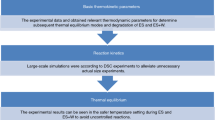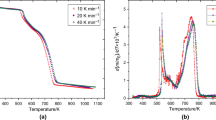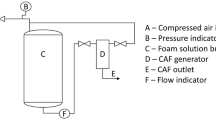Abstract
The fire that occurred at ALA nightclub was the deadliest nightclub fire in Taiwan. This study used the ALA nightclub fire as a case study and conducted a burning test based on the official fire investigation report. Fireworks that had been used during the performance were the cause of fire. Their heat release rate is approximately 180 kW, and the flame temperature is 300 °C. Soundproof foam collected from the fire debris was used to conduct a thermal analysis experiment under two different heating rates. In addition, related studies were referenced. It was found that when the sample was heated to between 45 and 55 °C, pyrolysis reaction started and the sample started to release harmful substances. The burning behavior of soundproof foam is considered ultrafast. When the heating temperature reaches between 225 and 370 °C, the sample releases 1,819.09–2,894.59 J g−1 of heat. It is evident that it poses a serious degree of thermal hazard. Finally, it is recommended that the emergency egress time in entertainment establishments such as nightclubs should be kept between 60 and 90 s or less as a reference for fire safety strategies for nightclubs.




Similar content being viewed by others
Abbreviations
- L :
-
Mean flame height (m)
- Q :
-
Heat release rate (kW)
- D :
-
Flame diameter (m)
- t :
-
Ignition time (s)
- α :
-
Flame growth coefficient (kW s−2)
References
Bryner N, Madrzykowski D, Grosshandler W. Reconstructing the Station nightclub fire—computer modeling of the fire growth and spread. In: International interflam conference, 11th proceedings, 3–5 Sept, 2007. London, England. 2007;2:1181–92.
Liu ZQ. Countermeasures and mechanisms of fire risk disposal during new period. J Saf Sci Technol. 2011;7(3):119–22.
Li CY, Li CS, Hsieh HR, Chien HW. Lessons from Nightclub Fire at Santa Maria, Brazil, Disaster Reduction E-Newsletter. In: Electronic newspaper of disaster reduction. National Science and Technology Center for Disaster Reduction. 2013; 93. http://www.ncdr.nat.gov.tw/upload/epaper/093_2.pdf.
National Fire Protection Association. NFPA 921: guide for fire and explosion investigations. Orlando: NFPA; 2011.
SFPE Hand Book of Fire Protection Engineering. Quincy: National Fire Protection Association; 2008.
Tsai MJ, Wang TC, Lee CH, Chen CC, Chen CL, Chan CW, Huang CR, Chiu YL. Research experiment for priority promotion of fire safety building sign for B1 entertainment establishments. Research report. Taipei: Architecture and Building Research Institute, Ministry of the Interior; 2011.
Chen CC, Chien WH. Technical manual of performance verification for fire escaping safety of building. Research report. Taipei: Architecture and Building Research Institute, Ministry of the Interior; 2011.
Floyd J, Forney G, Hostikka S, Korhonen T, McDermott R, McGrattan K. Fire dynamics simulator user’s guide. NIST Special Publication 1019. Maryland: National Institute of Standards and Technology; 2012.
Chi JH. Using thermal analysis experiment and Fire Dynamics Simulator (FDS) to reconstruct an arson fire scene. J Therm Anal Calorim. 2013;113:641–8.
Wu SH, Chi JH, Huang CC, Lin NK, Peng JJ, Shu CM. Thermal hazard analyses and incompatible reaction evaluations of hydrogen peroxide by DSC. J Therm Anal Calorim. 2010;102:563–8.
Chi JH, Wu SH, Shu CM. Thermal explosion analysis of methyl ethyl ketone peroxide by non-isothermal and isothermal calorimetric applications. J Hazard Mater. 2009;171:1145–9.
Hadjisophocleous GV, Benichou N. Performance criteria used in fire safety design. Autom Constr. 1999;8:489–501.
Acknowledgements
Appreciation is hereby expressed toward Dr. Tsai Ming-Ju and others from Architecture and Building Research Institute of Ministry of the Interior for contributing their research studies; the antecessors from National Fire Agency of Ministry of the Interior for providing precious information from the fire accident. We would like to express our sincerest gratitude.
Author information
Authors and Affiliations
Corresponding author
Rights and permissions
About this article
Cite this article
Yeh, CT., Shih, SJ., Chi, JH. et al. Thermal hazard analysis of ALA nightclub fire debris. J Therm Anal Calorim 117, 1065–1071 (2014). https://doi.org/10.1007/s10973-014-3913-1
Received:
Accepted:
Published:
Issue Date:
DOI: https://doi.org/10.1007/s10973-014-3913-1




